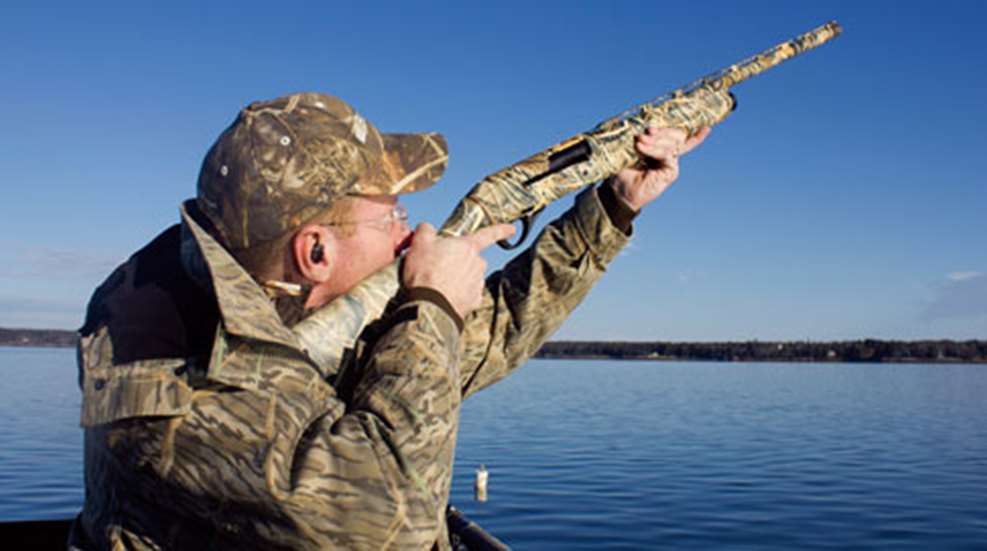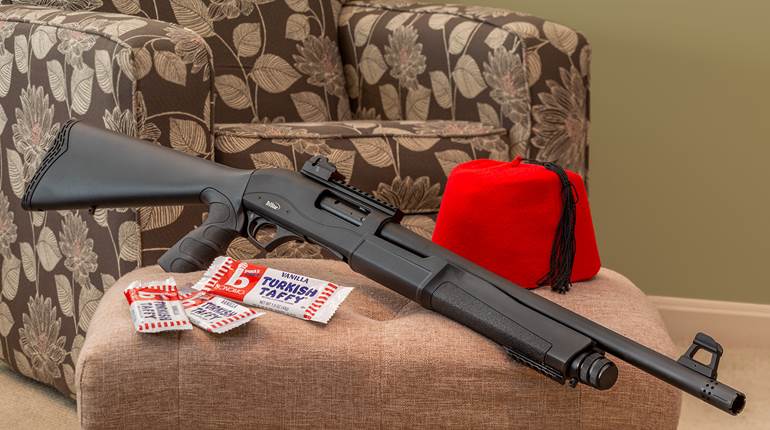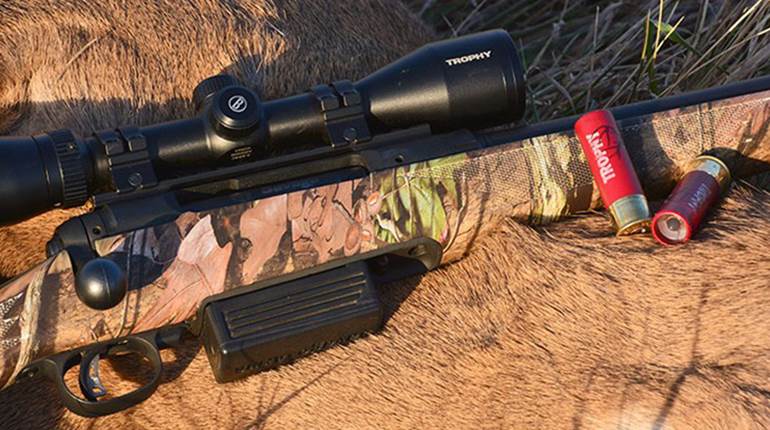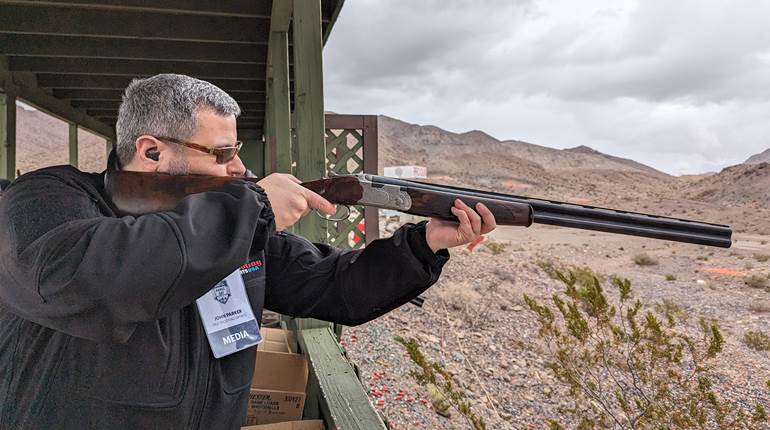
12/27/2012
You open the box of your new shotgun, you look for the instruction manual that’s under a plastic envelope containing some black oval-shaped things, toss them aside and open the manual to the assembly page. The gun is assembled, the magazine cap tightened, the choke tubes and wrench slid out of their compartments, and you’re ready for the range or field. Really? Why not? Because that little package of shims might just be your ticket to better shooting.
“There is a good deal of space around a flying bird, and a gun that fits your particular build is as necessary for a successful shot as a well-fitting shoe for a hiker. A man must have his gun fit him the same as his clothes,” Charles Lancaster explained in the 1889 edition of his book, The Art of Shooting. What was true in Lancaster’s day remains true in the 21st century.
Most shotgunners are content to take the gun as it comes from the factory and then try to fit themselves to it. Yet to understand why a proper-fitting shotgun is so important, we have to understand the “sighting” system of a shotgun. Shooting moving targets requires the shooter to have his full attention on the bird, never the bead or rib. The very best shots state that their concentration is 95 percent on the bird and five percent the gun, and then only in their peripheral vision. Therefore, the fit of the stock to the shooter must be such that when the gun is mounted the shooter’s eye is centered over the rib, without adjustment, shifting of the head, or looking at the barrel and front bead. Shotgunning is a fluid shooting art without the conscious alignment of sights, as in shooting a rifle or pistol. The properly fitted shotgun comes to the shoulder, the eye tracks the target, swings ahead and the shot is fired.
Granted, shotgun manufacturers attempt to stock their shotguns for “Mr. Average,” but who is that? For years, Mr. Average was a 5-foot, 10-inch tall man wearing a 15 1/2-inch-collared shirt with 30-inch sleeves, just as average-proportioned men were in the 1950s. Times change and today’s average man is more than 6 foot tall and wears a bigger shirt. The good news is that stocks can be adjusted, particularly with those little black shims, for a better fit and better shooting.
The basic dimensions of a shotgun stock are: length of pull, the distance from the trigger—the front trigger in the case of a double-triggered gun—to the center of the butt. That dimension determines where the shooter’s face is placed on the comb of the stock. Drop is the distance from a line straight down the rib to the top the stock. Drop is measured at two points on the stock, at the very front of the comb, and at the very end of the butt.
Cast, despite former American Rifleman field editor, the late Col. Charles Askins’, statement that it “would soon fade,” remains a vital part of gun fit. Cast is the bending of the stock slightly away from the shooter’s face. It allows the stock to be properly bedded in the shoulder pocket, which is offset from the center of the shooter’s eye, while allowing the cheek to lie properly along the comb, bringing the eye directly over the rib. Cast-off accommodates right-handed shooters and cast-on is for lefties. A shooter with a slim face needs a smaller amount of cast than someone with a broad jaw or heavy jowls, who will require considerably more cast. Virtually all shotguns of European manufacture have some cast, while American shotgun makers do not cast their stocks, relying, instead, on a lower comb.
The final stock measurement is pitch. This is the angle of the butt to the barrel. It determines how the butt contacts the shoulder of the shooter. Common factory pitch accommodates most men, but women routinely require more down pitch to accommodate their anatomy. Too, a man with heavy chest muscles will also require more pitch. Too little pitch causes the toe of the stock to painfully jab into the shoulder; too much pitch causes the stock to slide upward, whacking the shooter in the jaw.
Increasingly, manufacturers are supplying a variety of spacers and pads that allow adjusting the length of pull. With a wooden stock, adding a thicker pad, spacers or cutting the stock and reshaping the pad to shorten it will bring it to the proper length. Pitch is also easily changed on a wooden stock, but is more difficult with synthetics. Sometimes washers can be placed between the pad and stock to alter the pitch of such stocks.
Mossberg, Beretta, Benelli, Franchi, Winchester, Browning and, most recently, Remington’s new Versa Max, include shim kits that enable the individual to better fit a shotgun to him or herself. The shims simultaneously alter both drop and cast. So how does that work?
Little can be achieved unless the shooter has a good consistent gun mount, one that places the comb to his cheek and the butt on his shoulder in the same place 90-plus percent of the time. A proper gun mount is too much to cover here, but begins with the gun roughly parallel with the ground, with the butt of the stock held snuggly between the upper arm and chest. When the bird flushes, the muzzles begin tracking the target as the gun is brought to the cheek and lastly the shoulder. That mount technique brings the gun to the cheek with the barrel already tracking the target, and the shot is simple. However, if the shooter writhes about trying to adjust himself to the stock, the swing will be erratic or stop and the target missed.
So how is this nirvana of stock fit achieved? First, we need a safe place to shoot, and some means of hanging a 30-inch- or 40-inch-square sheet of paper at or slightly above eye level. Then we need to measure exactly 16 yards from the face of the paper to our toes. This distance is vital, because it enables us to properly interpret the target and apply that information to our shotgun.
The paper needs to be marked with a visible center dot. I use Birchwood Casey 3-inch orange dots, but any mark will serve equally well; I also use the tightest choke I have, but any will do.
When all is in position, mount the gun and, as if sighting a rifle, fire three shots at the same dot. Then, using another target, focus on the dot, slowly mount the gun and fire three more separate shots the instant the gun, cheek and shoulder come into contact. Finally, with a new target, focus on the dot, and mount quickly and fire three more shots. If you feel one shot was off, discount it and fire another.
To compare the three targets, locate the center of each of the three-shot patterns. If you have a good, consistent gun mount each of the three patterns should be pretty much superimposed on one another.
Once the center of each of the superimposed patterns are found, measure from the center of the patterns to the aiming dot. Because we’re at exactly 16 yards from the target, any error will represent itself in 16ths of an inch. For every inch the patterns deviate from the center of the aiming dot, the stock needs 1/16 inches of adjustment. For example, if the center of the patterns is 3-inches low but centered, then the comb of the stock needs to be raised 3/16 inches to bring the center of impact to dead center. In practical terms, the adjustment probably ought to be in the range of 1/4 inch or even 5/16 inch, since it is a good idea to have the center of impact about 60 percent above the target and 40 percent below so that birds can be always kept above the barrel.
Up and down movement of the point of impact is adjusted by the drop of the stock. If a particular shotgun shoots too high, then the lower shim is inserted. If it’s a wooden comb, it can be carefully filed and sanded to bring about the correct impact. Go slow and test frequently. If impact is too low, the higher shim is used or the comb can be built up using strips of leather held in place with plastic electrician’s tape, or one of the commercial comb raisers from Meadow Industries and others can be affixed to the comb to raise it.
Lateral displacement of the patterns, left or right, is in the realm of cast. A pattern that impacts to the left of the dot for a right-handed shooter needs to be moved to the right using cast off. Impact to the right of the dot dictates cast on for a left-handed shooter, or less cast for a righty.
Cast is subtle, normally 1/8 inch to 1/4 inch at the heel and about an additional 1/8-inch cast at the toe to better fit the butt into the shoulder pocket that runs diagonal from the top of the shoulder to the arm pit is all that’s necessary. For example, off-the-rack Berettas normally have 3.5 mm (3/16 inch) cast off. Cast off or on is tough to accommodate on a straight stock, but it can be done. The cheek-side of the stock can be dished out, but that’s impossible on a synthetic stock. However, on a pump or semi-automatic one can remove a bit of wood or plastic from the head of the stock on the side the cast is moving to, and then make some shims from stiff cardboard—shell-box cardboard make good shim material as does thin brass available at hobby stores—that are fitted between the stock and receiver to accomplish cast.
Once you have a good idea how your stock is fitting you, it is a good idea to record these dimensions. Little more than a yardstick and ruler are needed. With the shotgun in a vise, cleaning cradle or other secure means, hold the yardstick on top of the rib and then using the ruler, measure from the bottom of the yardstick to the top of the comb at the front and rear, and record the measurement. If your patterning found changes necessary, make note of them and add those changes to the data taken from the gun—then you have your own set of stock dimensions. Should you at some time want a custom stock made, you can supply these dimensions to any competent stockmaker, and he will produce a stock just for you.
Those manufacturers whose stocks accommodate shim kits can make achieving adjustments easy. The shims are not finite stock-fitting cures, as they only move the stock so much. If your dimensions are on the wide side of average, you may need to do some additional work, but for the now average shotgunner, they come pretty close.
The shims fit between the front of the stock and rear of the action. To access them remove the recoil pad—some require a screw driver, normally a Phillips, but the Benelli Super Black Eagle II’s pads snap off—then using a deep socket wrench of the proper size (13 mm services Beretta and Benelli guns), remove the stock, then exchange the shim for the one that best approaches your needed dimensions and replace the stock. Changing the shims on the Remington Versa Max is even easier. The dimensions for each shim are listed in the instruction manual. The shims work in tandem with the steel plate in the buttstock, and it is necessary to carefully follow the instructions in the owner’s manual to get it right. Fitting the metal plate over the stock bolt in a Benelli or Beretta can be a little exasperating—I use one of those magnetic rods mechanics use to retrieve dropped parts. Once the shim is in place, and the metal plate positioned, simply reinstall and tighten the stock bolt—do not overtighten it, just be sure it is good and snug. Most manufacturers specify a torque value for the stock bolt.
Once the stock is adjusted, go back to the range and re-shoot the targets to be sure your gun is doing the most important thing, shooting where you are looking.
Adjusting a stock can take time, but with easy-to-use shims and some range time, your percentage of hits can rise dramatically. Whether you have a new shotgun or want to make the old one shoot better for you, take a good look at that bag of shims, they’re there for a very good reason.





































